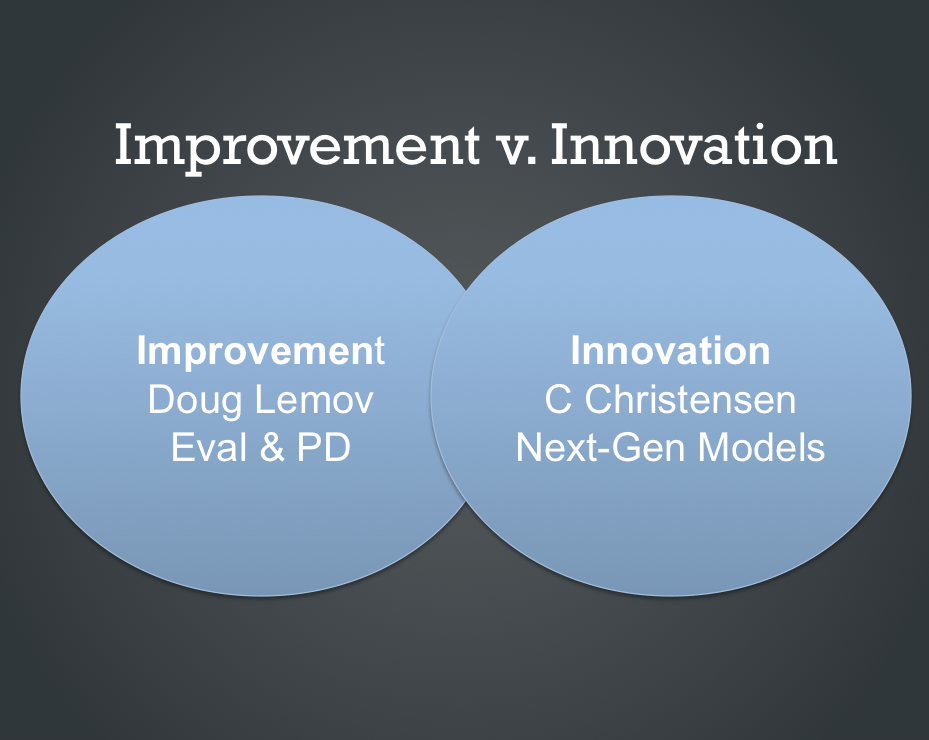Improvement vs. Innovation

For 20 years standards-based reform has been the dominant frame for U.S. college ready standards, annual testing, and school accountability. As noted in April, the focus on test-driven accountability resulted in a much-needed focus on data but in a narrow way that was often disconnected from powerful learning experiences. Standards-based reforms attempted to optimize the current model and underscored the importance of consistently good instruction.
Simultaneously, and usually quite separately, anywhere-anytime learning sprouted and grew. Online learning became prevalent in military and corporate training, higher education and then in K-12. New learning tools have led to new learning formats in all sectors.
These two strands are finally coming together in interesting ways but they are quite different. Standards-based reform is a series of improvement efforts with a focus on doing things better. Online learning and new learning models are examples of disruptive innovation–doing things differently to dramatically improve outcomes. Doug Lemov’s book, Teach Like a Champion, is about improvement. Clay Christensen’s book, Disrupting Class, is about innovation.
Improvement efforts usually leave the basic time-bound cohort-based structure in place and attempt to improve course offerings and course taking patterns: guidance services, academic supports and the quality of instruction. While not easy, these improvements can result in big system wide advancements in achievement and completion rates as seen in Cincinnati, New York City, and Kansas City, Kansas. These reforms require data-driven process management–a relentless focus on quality instruction in every classroom.
An aggressive improvement agenda requires capacity and political capital. EdLeaders make deposits in the political capital account by creating a shared vision, exhibiting trustworthiness, and building support among stakeholders. Improvement is hard, innovation is even more difficult and often requires more political capital–even when working from the edges (i.e., Horn’s areas of nonconsumption).
Innovation is usually riskier with a wider range of possible outcomes. New school development can be more politically difficult than school improvement efforts–especially when it is likely to cannibalize enrollment–but it’s also much more likely to provide improved results when based on thoughtful design principles such as Carnegie’s Opportunity by Design or Next Generation Learning Challenges.
Following are a few examples of the difference between improvement and innovation initiatives in K-12:
| Improvement | Innovation | |
| Goals | Boost grad rates | P-TECH schools: diploma, AA degree and a computer science job |
| Time | Double block math | Flipped classroom strategies to extend learning |
| Personalization | Differentiated instruction | Blended format with adaptive learning |
| Progress | Remediation to avoid retention | Competency-based progressions where students show what they know |
| Path | Internship | CTE-linked flex academy (eg GPS) |
| Providers | Local school | Multiple providers full & part time |
| Extended Reach | Station rotation model | Teaching online |
Innovation requires design thinking and iterative development. Considering the demands of improvement and innovation, Lyle Kirtman has identified 7 competencies for high performing leaders:
- Challenges the Status Quo
- Builds Trust through Clear Communication and Expectations
- Creates a Commonly Owned Plan for Success
- Focuses on Team over Self
- Has a High Sense of Urgency for Change and Sustainable Results in Improving Achievement
- Commitment to Continuous Improvement for Self and Organization
- Builds External Networks and Partnerships
EdLeaders need to consciously gauge their community’s appetite for change and their internal capacity to deliver. They need to consider the amount of political capital they’ve earned and what they’ll need to do make deposits sufficient to support an aggressive change agenda. They need to balance the amount of improvement and innovation they can phase in over several years. Improvement is playing for singles and doubles. Innovation in swinging for the fences. EdLeaders need to lead community conversations that create the right balance of the two.





0 Comments
Leave a Comment
Your email address will not be published. All fields are required.